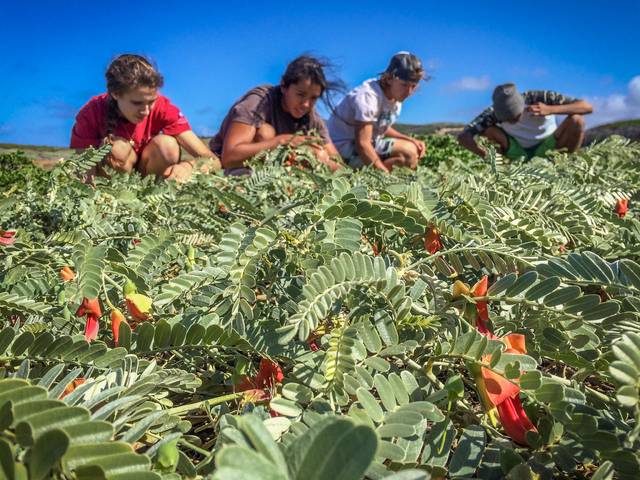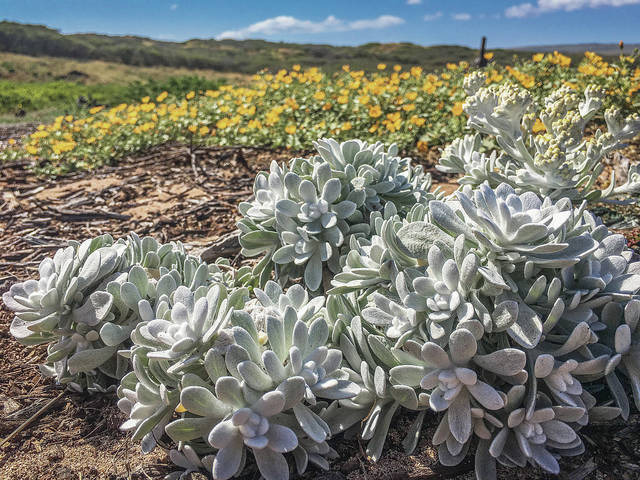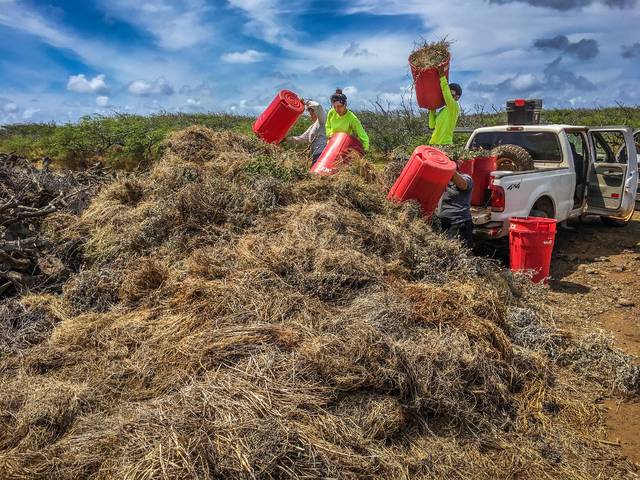Butch Haase can’t help himself. He pulls weeds every chance he gets when he’s in Mokio Preserve — with his bare hands, no less.
“You get better results without gloves,” he said. “To me, weeding is like meditation; I love it! One less weed and invasive plant means more space to reintroduce native species.”
Haase is the visionary executive director of the Molokai Land Trust, which manages the 1,769-acre preserve in northwest Molokai — a breathtaking expanse of savanna, dryland forest, seasonal wetlands, 5 miles of rugged shoreline and remnant native coastal strand and dune ecosystems.
His staff is small — just two full-time field workers and an intern — so he’s actively involved with every aspect of preserve work. Besides weeding, that means everything from propagating plants, operating backhoes and overseeing education and outreach programs to writing grants, preparing reports and developing partnerships. He’s even climbed over 450-foot sea cliffs to collect seeds and examine native plant communities.
The trust’s goal is to restore every inch of Mokio Preserve with the native species that once thrived there, and Haase is the perfect person to lead the effort. He holds a bachelor’s degree in Environmental Science with a focus on forest ecology and hydrogeology, the study of a site’s surface and subsurface water movement in relation to its geology. He also has extensive experience in landscape design and construction, native Hawaiian reforestation, botany and horticulture (his knowledge about the latter two is self-taught).
Although 50-plus native species are flourishing at Mokio, non-natives still cover 92 percent of it. The task ahead is daunting, and Haase advocates a long-term, collaborative approach.
ABOUT THE TRUST
The Molokai Land Trust, a nonprofit organization, was established in 2006. It manages 1,965 acres on Molokai, including 1,769-acre Mokio Preserve, a gift from Molokai Ranch in 2008, and 196-acre Kawaikapu Preserve in East Molokai, which it purchased in 2009.
Its mission is “to protect and restore the land, natural and cultural resources of Molokai and to promote, educate and perpetuate the unique Native Hawaiian traditions and character of the island for the benefit of the future generations of all Molokai, particularly Native Hawaiians.”
The organization depends on volunteers and donations. Tax-deductible contributions can be made out to Molokai Land Trust and mailed c/o P.O. Box 1884, Kaunakakai, Hawaii 96748. Donations can also be made online via credit card at molokailandtrust.org/donate.php.
“As far as plants go, Hawaii is one of the endemic hot spots of the world, but it’s also the extinction capital of the world,” he said. “We can re-establish native species by removing invasives, building fences to keep out predators like deer and partnering with like-minded individuals, corporations, government agencies and other nonprofits. It’s not going to be finished tomorrow, but Mokio can once again be a beautiful, diverse native ecosystem that recharges the aquifers and reduces sediment flow to the nearshore marine environment.”
There’s another important benefit. Most of the schoolchildren who visit the preserve can recite the oli (chants) and mele (songs) that refer to native plants, but they can’t identify them.
“They don’t have any tangible connection to them,” Haase said. “To me, that’s tragic. By rebuilding Mokio’s native ecosystems, we can re-establish links between the land and Hawaiian culture.”
In ancient times, the area was inhabited sporadically because it doesn’t have permanent fresh- water sources. Villagers made brief trips there to fish and collect basalt for adzes, salt from indentations in the rocky shoreline and alaea, a red clay used for dye, medicine and purification ceremonies. Archaeologists have documented adze quarries, fishing shrines, small temporary house sites and refuse heaps filled with opihi and cowry shells — clues of past visitors’ meals.
Long ago, Hawaiians didn’t venture more than a quarter mile from their camp to gather wood for fuel. Charcoal analyses from coastal firepits revealed that as recently as the 1500s, mehame and olopua trees were being burned.
“Those are mesic forest species, which means the forest came all the way down to the cliffs just 500 years ago,” Haase said. “The analyses also showed the presence of mesic species that aren’t found anywhere in West Molokai today.”
There are no written records about Mokio’s original plant communities, but he and his team are studying small pockets of mixed native vegetation to get an idea of what formerly existed and using them as models for their work.
They launched the 60-acre Anapuka Dune Restoration Project in late 2009. To date, the entire area has been fenced, and 58 acres have been cleared of invasive kiawe and lantana and replanted with a multistory canopy of more than 20 natives that can survive in the arid, windswept, salt-laden coastal environment.
Two of note are federally listed endangered species. The silvery enaena (a member of the daisy family) started colonizing at Anapuka on its own a few years ago. Haase surmises remnant enaena were hanging on the cliffs where animals couldn’t get to them. Once fences were built and invasive plants were removed, windblown seeds were able to take root and prosper.
Before a single ohai papa appeared in 2010, it had not been seen at the site for 150 years. Flaunting distinctive orange flowers and hugging the ground because of the windy conditions, it is a species unique to Mokio Preserve.
“When it popped up, it was very important because it added critical diversity to ohai’s existing gene pool,” Haase said. “It looks like a vine, but it’s actually a two-dimensional tree. Look closely and you’ll see its trunk, with leaves and flowers spreading out wide from it.”
Another rare native, the akoko (E. skotsbergii), can be found along the coastal cliffs less than a mile east of Anapuka. Like ohai, it grows low and flat, and, being deciduous, it loses its leaves during the dry season from June through October.
“When it’s bare, it looks like a little twig on the ground,” Haase said. “It’s brittle; if you step on it, you’ll kill it. What’s alarming is it’s not something you would notice, and you can wipe it out with one footstep.”
Slowly but surely, Mokio’s intricate web of life is returning, including the endangered yellow-faced bee, an invaluable pollinator, and a variety of seabirds. Thanks to decoys, predator control, restoration of native plants for suitable habitats and a solar-powered unit that broadcasts mating calls, Layson albatrosses, noio (noddy terns), uau kani (wedge-tailed shearwaters) and koae kea and koae ula (white- and red-tailed tropic birds) are soaring overhead. Hopes are high they alight to nest in large numbers as they did long ago.
Attracting seabirds is key because their excrement adds nutrients to the soil and nearshore waters, which contributes to the health of native plants and increases the density and diversity of fish, coral and seaweed.
Haase realizes Mokio Preserve will not top every visitor’s itinerary, but he believes it will inspire those who do experience it firsthand.
“This is a hot, dry, windy, remote region that has been overwhelmed by weeds and invasive species,” he said. “No one thought much could be done about that, but the transformation is happening, and it’s a blueprint for similar areas throughout the state. Mokio is beginning to mirror what the Hawaiians saw centuries ago when they spent time in this amazing place.”
—
VISITING MOKIO PRESERVE
The Molokai Land Trust offers managed public access to Mokio Preserve. Be aware there are no clearly marked trails, sanitation facilities or potable water, and you must have a four-wheel-drive vehicle to get there — an hour’s drive each way from the main road, Highway 460. Call (808) 553-5626 or email molokailandtrust@gmail.com for more information.
>> Subsistence activities: The preserve is open to Molokai residents for hunting and fishing between sunrise and sunset on weekends and state and federal holidays. Kamaaina from other islands can hunt and fish there guests of a Molokai resident, who must accompany them. There is no charge, but you must have a pass issued by the preserve.
>> Volunteer work: Weeding, planting native species and other volunteer opportunities are available year-round on weekdays for those 12 and older (kids 12 to 17 must be accompanied by a parent or authorized guardian). You’ll meet a staff member at a designated time and place who will provide round-trip transportation to the worksite.
>> Private visits: Guided excursions for small groups can be arranged for a contribution to the trust and with a month’s notice. Group size depends on the availability of four-wheeldrive vehicles. This activity is not recommended for children under 12.
>> Fundraising events: The trust hosts guided tours to Mokio Preserve as part of its annual fundraising efforts. Upcoming dates are Jan. 26, Feb. 23 and March 30. Each tour is limited to about 20 people. A $50-per-person suggested donation is encouraged. Wine-and-pupu events from 5 to 8 p.m. at various locations will be held Jan. 24, Feb. 21 and March 28. Bring a pupu; suggested contribution at the door is $35 per person. Advance reservations are required for the tours and dinners. Call (808) 366-6675 or email molokailandtrust@ gmail.com.
Cheryl Chee Tsutsumi is a Honolulu-based freelance writer whose travel features for the Star-Advertiser have won several Society of American Travel Writers awards.








